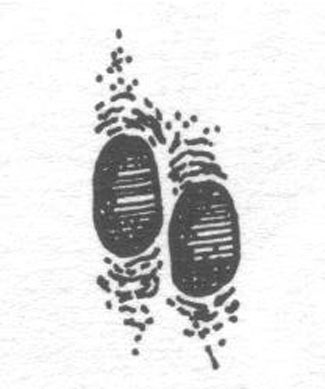By Jack Souther,
Whistler Naturalists
On those clear cold mornings when yesterday's ski tracks are covered with a blanket of fresh powder I am always amazed to see so many new tracks on the hill. Not tracks made by skiers and boarders, but tracks left by the hundreds of other creatures that emerge from their daytime hideaways after the evening sweep and inhabit the slopes until the first avalanche bomb signals the start of another ski day.
A short distance above the valley several deer have crossed the slope. Their small feet on stilt-like legs have punched deep furrows into the snow contrasting with nearby tracks left by bobcat or lynx whose large, round, cat-feet support them like snowshoes. The mincing steps of a ptarmigan or grouse leave tracks that end abruptly where the first beat of wings has made a faint set of parentheses in the snow. And the distinctive "rabbit tracks" of snowshoe hare, made by two big feet and two little feet, are present from the valley all the way up to treeline.
There are others; squirrels, weasels, coyotes, raccoons. But the most prolific track-makers of all are marten ( Martes americana ). These slim, long bodied carnivores bound across the slopes leaving side by side pairs of small tracks resembling widely spaced ditto marks in the snow. The animals themselves are seldom seen. In 20-odd years of skiing Whistler I have only twice seen marten loping across a ski run. Like all members of the weasel family, which includes wolverine and mink, marten are fearsome predators, efficient scavengers, and skillful thieves. Their tracks, often leading to and from holes dug into the snow, are a record of the nightÕs search for food.
A male marten can weigh more than a kilogram and measure up to 60 cm long. Its bushy tail is about half the body length and, unlike the weasels with their winter ermine coats, the martin retains its brown colour throughout the year.
Versatile hunters, they are equally adept on the ground, where they prey on mice, voles, pikas, and hares, and in the trees, where they pursue and capture squirrels. Marten are also great scroungers and crafty thieves. Judging from their tracks, which often converge on the remains of a lunch dropped by some hapless skier, they have learned to patrol the lift-lines for fallen treats. They are also adept at sneaking into the on-mountain restaurants and raiding the pantry. But even the wily marten sometimes get careless. Each year five or six of the more persistent offenders are live-trapped at the restaurants and relocated to similar habitat on a more remote part of the mountain where there is less temptation to steal from human larders.
Next time you are on the lift waiting to make your own first tracks take a closer look at those left by the other "locals." They have a story to tell about the apr�s-ski drama of life and death on the slopes.
Upcoming Events
:The Whistler Naturalists is presenting a Whistler Nature Photo Exhibit Feb 1-28 with pictures being displayed at Village 8 Cinemas as part of ArtWalk. They will also be hosting a Nature Slideshow Exhibit on Feb 24, 7:30 p.m. at Millennium Place. Both exhibits will feature images of the Whistler Valley and beyond from both amateur and professional photographers. For more information contact Tracy Howlett at tracy_howlett@hotmail.com
Calling all inspiring nature writers Ñ Do you have an interest in natural history or want to educate others about your favourite flora and/or fauna? Write your very own Naturespeak article. For more information contact April McCrum at 604-932-0919 or aprilmccrum@yahoo.ca.




